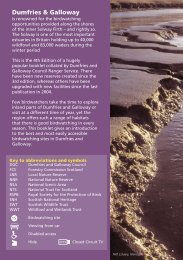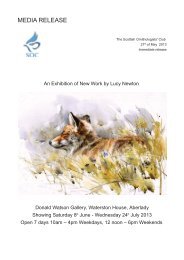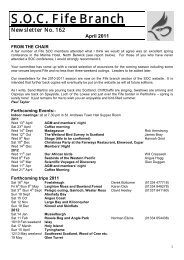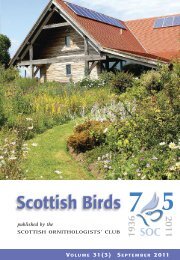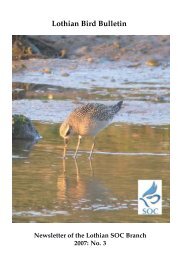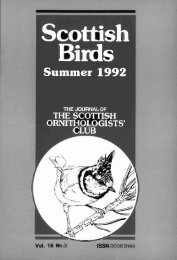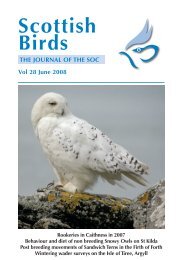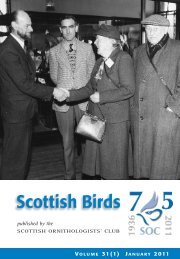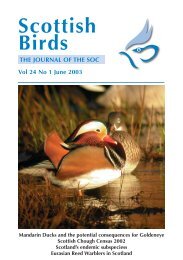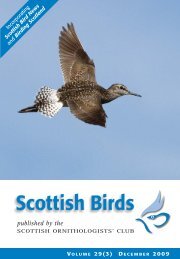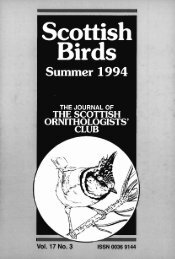V 14 No.4 - The Scottish Ornithologists' Club
V 14 No.4 - The Scottish Ornithologists' Club
V 14 No.4 - The Scottish Ornithologists' Club
You also want an ePaper? Increase the reach of your titles
YUMPU automatically turns print PDFs into web optimized ePapers that Google loves.
<strong>Scottish</strong> Birds (1987) <strong>14</strong>: 205-208 205<br />
Breeding Status of the Ring Ouzel in Southeast Scotland<br />
1985-86<br />
IAN R. POXTON<br />
In 1985-86 a survey was carried out of Ring Ouzels<br />
breeding in the three main upland areas of Southeast<br />
Scotland. <strong>14</strong>3 territories were found in 30 valleys. Most<br />
of the valleys in the Moorfoots and Lammermuirs held<br />
territories, but only two out of eight in the Pentlands.<br />
Territories were associated with valleys in which heather<br />
was the predominant vegetation and nest sites were<br />
almost always under clumps of heather.<br />
Introduction<br />
<strong>The</strong> Ring Ouzel Turdus torquatus is<br />
commonly encountered in the uplands of<br />
southern Scotland. General impressions<br />
suggested that its distribution was patchy,<br />
but documentation of the number of<br />
breeding pairs in the region was lacking. In<br />
1985 a systematic survey was made by<br />
members of the Edinburgh Branch of the<br />
<strong>Scottish</strong> <strong>Ornithologists'</strong> <strong>Club</strong> Discussion<br />
Group and the Lothian Ringing Group. <strong>The</strong><br />
three main hill ranges in the area, the<br />
Pentlands, the Moorfoots and the Lammermuirs,<br />
were surveyed with the aim of determining<br />
the distribution and numbers of<br />
breeding Ring Ouzels, and relating this<br />
distribution to habitat.<br />
From a study of breeding Ring Ouzels<br />
in one valley system in the Pentlands between<br />
1979 and 1984 (Poxton 1986), baseline<br />
information such as time of arrival of<br />
birds, general habitat, territory size and<br />
behaviour was already available as a guide<br />
to observers.<br />
Methods<br />
<strong>The</strong> three hill ranges were divided into 42<br />
valley systems and allocated to observers.<br />
Visits were made on at least two occasions<br />
between mid April and mid June, and it was<br />
recommended that early mornings or evenings<br />
of still days were the best times to find<br />
. ~. -<br />
~ ..>4 '~:'.1<br />
'/ti - ......<br />
~~ ..... Ujtv.<br />
Ring Ouzel.<br />
R.A. Richardson



